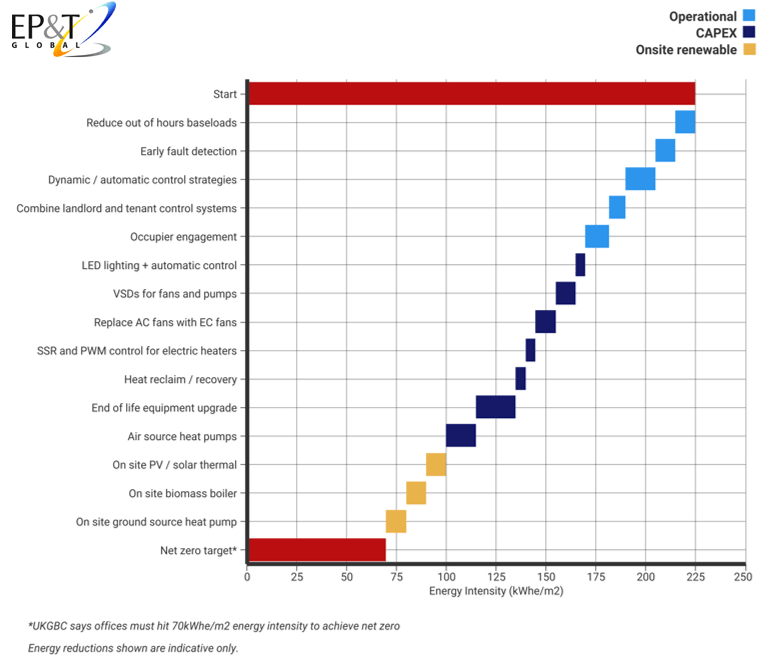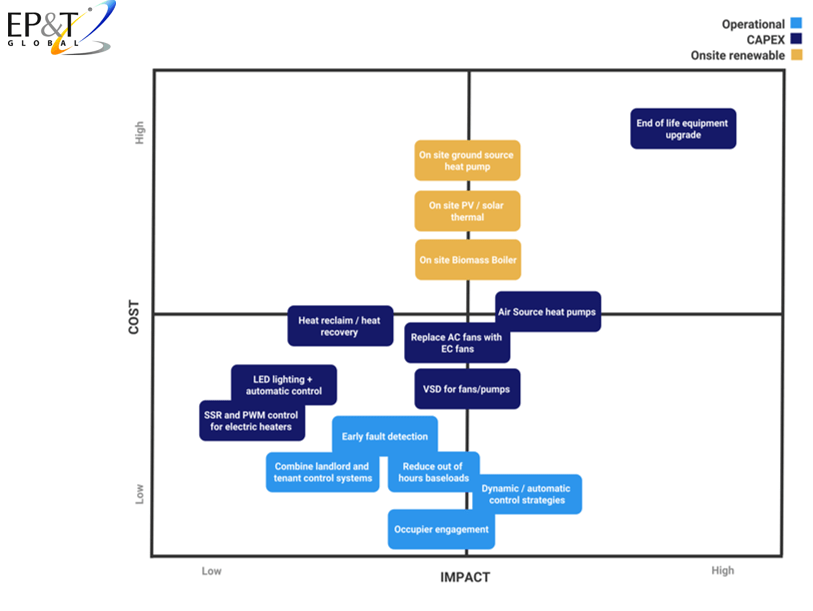The IIGCC (Institutional Investors Group on Climate Change), a coalition of more than 250 pension funds and investment managers representing assets of €33tn, recently announced their Net Zero Investment Framework, clear evidence that climate change action has progressed beyond ideological debate to become a demonstrable market trend. Investors require consensus on industry best practice in achieving net zero.
The IIGCC framework recommends investors establish ambitious targets to limit emissions at a portfolio level, as well as for their holdings by asset class. The framework is far-reaching, and contemplates a range of investment areas beyond commercial real estate. When referencing buildings, the framework recommends setting goals in 5 year increments to ensure that while investments in building efficiency are being made, alignment to overarching portfolio targets is maintained at the constituent asset level.
Interestingly, IIGCC puts emphasis on the availability and quality of tenant level data, and suggests that actions and investments are best made by building owners and tenants in cooperation, with the cost of retrofits shared through the service charge. This approach seeks to redress the split incentive that often exists when assessing sustainability driven investment, and reinforces the need for service charge friendly solutions.
Alongside the broader ESG risks that IIGCC discuss, decarbonising the built environment is crucial in achieving net zero. In the UK for example, the operation of buildings currently accounts for circa 30% of emissions, mainly from heating, cooling and electricity consumption. In 2019, the UKGBC (UK Green Building Council) published their Net Zero Carbon Buildings framework, providing a roadmap for asset owners and operators to achieving the deep cuts needed in greenhouse gas emissions by 2030, and net zero emissions by 2050.
Importantly, the UKGBC framework identified and expanded on the role of in-use building performance and the need to improve operational efficiency. UKGBC pointed out the need to make strides to address the longstanding imbalance of prioritising efficient design over efficient operation. In fact, the UKGBC recommends improving operational energy use in existing assets as a first step for businesses once they’ve established their net zero scope.
Unfortunately, regulation still currently lags behind in this area, with legislation such as MEES relying on the static information from an EPC (Energy Performance Certificate) which:
a) does not account for how a building is operated,
b) is valid for only 10 years so does not encourage ongoing progress, and
c) isn’t required on historic buildings, which also happen to be the least efficient.
The UK government are aware of the shortcomings in this area, as mentioned in the report by BEIS (Department for Business, Energy & Industrial Strategy), Energy efficiency: building towards net zero (2019) where they recommend a step change in the Government’s approach towards regulating the sector, including mandating operational performance ratings.
With the UK Government, industry bodies, and real estate investors seeing operational energy efficiency as the next big battleground on the road to net zero, much can be learned from the success of the National Australian Built Environment Rating System (NABERS).
In operation since 2004, NABERS takes into account operational efficiency by measuring actual impact, not intent, with the focus of the scheme being a rating system reflective of a building’s energy consumption and greenhouse gas emissions, rather than its design or building materials.
This principle was considered important as “energy-efficient designs do not perform at the level claimed (often because of changes made during construction, poor commissioning, etc), and that energy consumption varies over time, depending on maintenance and usage.”
This is a similar disconnect to that which EP&T have observed for several years. Buildings that are designed to be energy efficient, but are poorly managed, are often more energy intensive than buildings with less efficient design and are well managed.
Under the Building Energy Efficiency Disclosure (BEED) Act 2010, NABERS ratings are legally required for commercial office buildings of 1,000 square metres or more, and there is mandatory disclosure of a building’s NABERS Energy Rating at point of sale or lease. Following an independent assessment, buildings are awarded a NABERS rating of between 1 and 6 stars, with 1 representing poor performance and 6 a high performing building.
In support of the scheme, the Australian Government has also gradually increased the minimum rating it will accept as a tenant, with Federal and State Government procurement policy stating that all rented space must have a NABERS rating of 4.5 stars or higher. This leadership by example has effectively established a market standard, as property prices correlate to NABERS ratings, including downward pressure on rents if a rating decreases. Now, circa 78% of Australia’s office space is rated by NABERS, and the latest Sustainable Portfolio Index shows that 82% of participating commercial office buildings currently have made a net zero commitment.
So with NABERS widely adopted and increasingly important to building owners and occupiers, how has the focus on operational efficiency translated into positive environmental outcomes? Over the last 10 years, the median NABERS rating has increased from 2.5 stars to 4.5-5 stars. In the same period, office buildings using NABERS to measure their environmental performance have reported an average emissions improvement of 11.5%, and have saved over AUD $400million in energy bills.
Buildings that are designed to be energy efficient, but are poorly managed, are often more energy intensive than buildings with less efficient design and are well managed.
Research published by UKGBC on energy performance targets for commercial offices states that achieving an energy intensity of 70kWh/m2 is aligned with the level of operational efficiency required for net zero, also confirming that this level of efficiency is equivalent to a 5* NABERS rating. Due to the success of NABERS, investors such as Brookfield, Charter Hall, Lendlease, and CBUS property have each already achieved 5* ratings across entire funds within their portfolios.
Learning from the success of NABERS and adhering to guidance from UKGBC, building owners and operators in the UK and Europe should now be actively prospecting ways to improve their operational efficiency.
Fortunately, minimising energy wastage need not require significant investment. At EP&T we have been associated with the NABERS scheme since inception and have developed proprietary software analytics that track and manage NABERS ratings.
Having monitored hundreds of buildings across geographies and asset classes, we’ve been able to evaluate and benchmark the initiatives required to achieve net zero. While every building is unique, the relative contribution of most initiatives are broadly consistent, illustrated in the waterfall below.

Further insight comes from indexing contribution against cost of contribution. A simple cost vs impact quadrant analysis demonstrates that on the road to net zero, operational efficiency is a strong candidate for prioritisation over CAPEX and onsite renewables.

While CAPEX and onsite renewable projects represent a significant portion of the emissions saving opportunity in any asset, commencing the journey by reducing energy wastage via low cost and usually ROI positive optimisation measures sees owners and operators generate immediate energy savings without requiring capital. Often, customers will assign the positive operating cashflow to subsidise other projects with the same or similar objectives. Focusing first on the reduction of avoidable wastage through data analytics, has the extended benefit of providing meaningful intelligence through which to accurately scope CAPEX and renewable projects off an optimised consumption baseline. This informed approach often minimises additional capital expense through appropriate sizing of equipment upgrades.
As mentioned in the IIGCC Net Zero Framework, acquiring high fidelity energy data is crucial to inform conversations between landlord and tenant, and enables sound decision making. From a technical perspective, data is also the cornerstone of building optimisation, measurement and verification of savings achieved through investment, and accurate reporting. EP&T’s position as a data platform provider, combined with performance focused support, allows us to guide our customers through the process of achieving operational efficiency, then leveraging analytics to drive tenant engagement and investment planning.
A simple, prioritised checklist will minimise cost while maximising financial and environmental benefit:
- Improvement in Operational efficiency
- Engagement of all stake holders including tenants
- Low to medium cost Capex – low hanging fruit (Lighting upgrade, VSD etc.)
- Onsite renewable power
- Offsite renewable – Green power purchase
- Major refurbishment/upgrade
- Carbon Offset
While the journey to achieving net zero is undoubtedly long, and slower than many would want to see, it’s exciting to witness leaders in industry aligned and speaking with one voice on the need to address the systemic challenges that prohibit accelerated progress. The promise of new technologies and decarbonisation of the grid may lead some to hold their capital and see how the market evolves. But time and again we see environmental performance correlates to financial performance and while investors are becoming progressive in this regard, late adopters will suffer competitively.
With the market having established consensus on the route to net zero, the onus falls both on asset owners to pull the trigger and start investing, and on service providers to present owners with financial and technological solutions that are financially and environmentally compelling.





